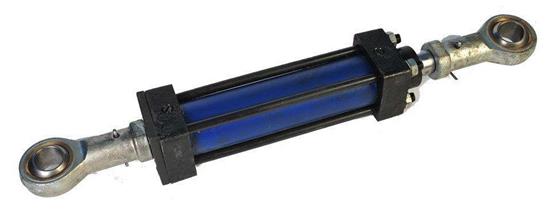Hydraulic cylinders may be unfamiliar to many people. They are actuators in hydraulic transmission systems and are energy conversion devices that convert hydraulic energy into mechanical energy. With its simple structure and reliable working characteristics, it has been widely used in various mechanical hydraulic systems. The following Xiao Bian talked about the specifications, classification and structure of hydraulic cylinders for everyone.

  Hydraulic cylinder specifications
1. The commonly used standard is Φ140/100-800 which means the cylinder (straight) diameter (inner diameter) is 140, the rod diameter is 100, and the stroke is 800. The bore diameter, rod diameter, stroke, connection method, installation distance, work pressure, production time, and factory serial number are generally indicated.
2,180/150/125/100427019MPa50-75 tons; cylinder material is 45# or equivalent material, safety margin is large; the Seal Ring adopts Japanese Wal-Mart products; parts are processed by CNC machine tools, precision is easy to be effective Guaranteed that the consistency of production quality is good.
3, three, four hydraulic cylinders; rated working pressure 19MPa; stroke 3880 ~ 6200mm; maximum out of the sleeve diameter of 195mm; cylinder thrust 20-56 tons, for car 40-85 tons. The use of high-end three-dimensional design and simulation software for the design of the cylinder, check the strength of the key parts of the cylinder, the simulation of the hydraulic system and flow field.
   Classification of hydraulic cylinders
Hydraulic cylinders come in a variety of categories.
1, according to the structural characteristics of points: piston, plunger and swing
2. According to the mode of action: single action and double action
A single-acting hydraulic cylinder can only make the piston (or plunger) move in a single direction, that is, the pressure only leads to a cavity of the hydraulic cylinder, while the opposite direction of movement must rely on external force (such as spring separation or self-weight, etc.) to achieve;
Double-acting hydraulic cylinders, the movement in both directions are driven by pressure oil.
   Structure of hydraulic cylinder
1. The hydraulic cylinder consists of a cylinder head (guide sleeve), a cylinder block, a piston rod, a piston head, a sealing device, a buffer device, and an exhaust system. Hydraulic cylinders are hydraulic actuators that convert hydraulic energy into mechanical energy and perform linear motion. Hydraulic cylinder structure is simple, smooth movement and reliable work.
2. The cylinder of the hydraulic cylinder adopts high-quality carbon structural steel forgings to ensure the homogeneity of the material. The internal hole of the cylinder is strongly rolled to improve the surface smoothness and hardness, high rigidity, good wear resistance, and the hydraulic cylinder long lasting.
3, the hydraulic cylinder piston rod and piston head using carbon structural steel forgings, the surface after chrome-plated grinding, high hardness, anti-pressure.
4. The sealing device of hydraulic oil cylinder is sealed with imported high-quality Sealing Ring, which has good wear resistance and heat resistance, low friction, avoids leakage of oil cylinder, reliable operation and prolongs the service life of sealing ring.
5. The cushioning device of the hydraulic cylinder can prevent the piston from decelerating at the end of the stroke and the speed is close to zero, reducing the inertia force of the moving parts of the piston, preventing the collision between the piston parts and the cylinder body, thereby reducing noise and vibration, and avoiding the hydraulic cylinder body. Damages and extends the service life of the hydraulic cylinder.
6. The exhaust system of the hydraulic cylinder ensures the smoothness of the hydraulic cylinder during operation and prevents intermittent impact and vibration.
Hydraulic cylinders have excellent materials to ensure that each component has sufficient strength, rigidity and durability. At the same time, the buffer device and the exhaust device ensure the smoothness and durability of the hydraulic cylinder in use. The above is the introduction of the hydraulic cylinder specifications, classification and structure composition, I hope everyone can read after the harvest.
Extrusion is a metal forming process , in which billet is passed through a die , to get required cross section of component .
Non cutting process
Production of Fixed cross section
Types of extrusion process
Direct extrusion process
Indirect extrusion process
Impact extrusion process
Hydrostatic extrusion process
Tube extrusion process
Die Core,Extrusion Die Core,Extrusion Tips Dies Mold,Cobalt Based Alloy Extrusion Dies
Shenyang New Industry Co.,LTD , https://www.topcobalt.com
